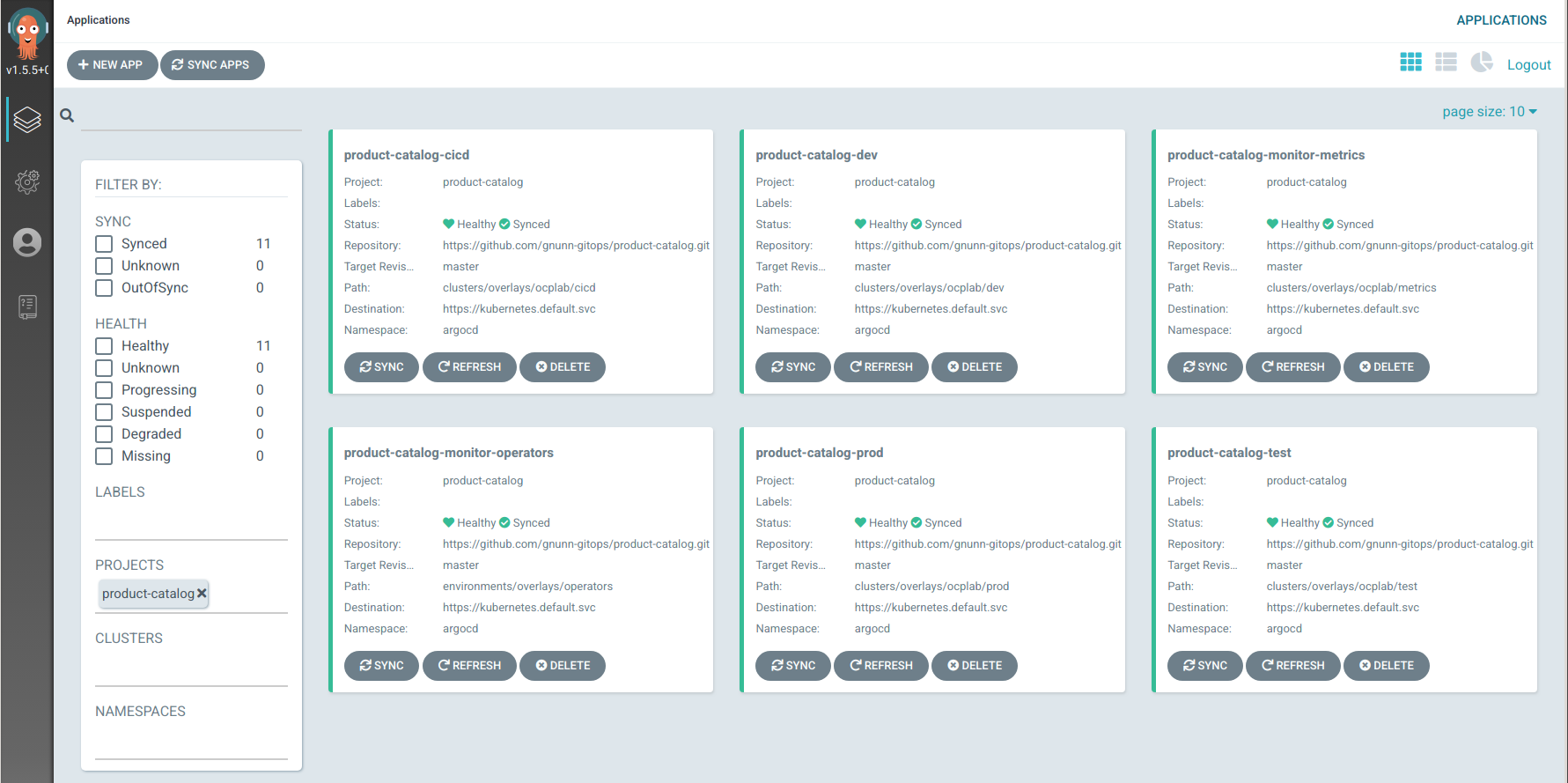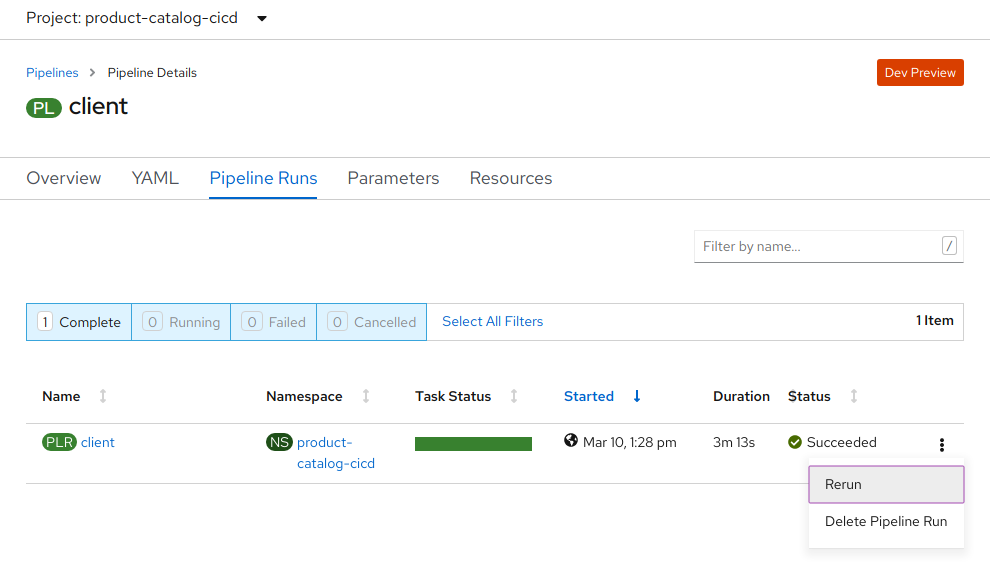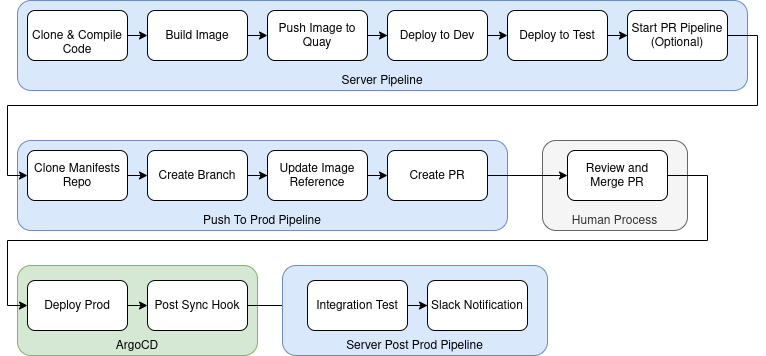This is an OpenShift demo showing how to do GitOps in a kubernetes way using tools like ArgoCD and Kustomize. The demo application is a three tier application using React for the front-end with Quarkus providing APIs as the back-end. The back-end was originally written in PHP and then ported to Quarkus. The application itself is a simple product catalog:
The topology view in OpenShift shows the three tiers of the application:
To run the demo locally on your laptop, you will need to have a MySQL or MariaDB database available. You will need to create a product database using the SQL in this repo and then update the quarkus application.properties file to reflect the location of the database.
The following repos will need to be cloned:
To run the quarkus application, execute mvn quarkus:dev from the root directory.
To run the client application, go into the client directory and run npm run start.
This application makes heavy use of Kustomize and ArgoCD to deploy the application in a GitOps manner. I had originally thought to make this demo consumeable for others but as I've extended it to more and more infrastructure (github/slack/etc) it's becoming challenging. At this point this repo is more of a reference example then a demo someone else can run.
If you really want to to deploy this application into your own cluster, you will need to create a new repo and setup Kustomize overlays that point to this repo. Since Kustomize supports referencing remote resources you do not need to fork this repo, a new one will suffice.
This project requires Nexus and SonarQube be available, this project used to deploy them directly but I have opted to move these as a separate deployment so it can be shared amongst multiple projects. To see how I deploy them visit the dev-tools repository.
Deprecated In order to make this easier, I had created a product-catalog-template . It includes detailed instructions with regards to pre-requisities and what needs to be modified to deploy the demo in your own cluster.
Once deployed in your cluster under ArgoCD it should appear as follows:
The demo uses OpenShift Pipelines to build the client and server images for the application. The demo does not install PipelineRun objects via ArgoCD since these objects are transitory and not meant to be managed by a GitOps tool. To load the initial PipelineRun objects, use the following command:
oc apply -k manifests/tekton/pipelineruns/client/base
oc apply -k manifests/tekton/pipelineruns/server/base
To test the pipelines are actually taking changes, you can add a logo to the product catalog. The code to do this is commented out and can be found in the nav.jsx file.
Once you make the code change, start the client pipeline. Note that in OpenShift Pipelines the GUI does not support creating a new PipelineRunTask with a workspace, if you want to drive it from a GUI go into the PipelineRuns and simple rerun an existing one.
The demo uses a pipeline called push-prod-pr that creates a pull request in github. When the pull request is merged ArgoCD will see the change in git and automatically deploy the updated image for you. The client and server pipelines can run the push-prod-pr automatically if you set the push-to-prod parameter to true to have it trigger the pipeline automatically. The default for this parameter is false.
For the server pipeline the process has been enhanced so that a post-sync hook in ArgoCD will trigger a pipeline to run an integration test after the deployment and send a notification of the status to a slack channel. This process is depicted in the diagram below.
To execute the pipelines you will need to create pipelinerun objects, base versions are available in manifests/tekton/pipelineruns. A script is also available at scripts/apply-pipelineruns.sh to load the client and server pipelineruns however you will need to modify the pipelineruns to reflect your cluster and enterprise registry.
The demo is used and tested primarily with an enterprise registry, in my case I use quay.io. See the product-catalog-template for more information on this.
The demo uses the git commit hash to tag the client and server images in the registry, when using quay.io it is highly recommended to deploy the Container Security Operator so that quay vulnerability scans are shown. From a demo perspective, I find showing how older images have more vulnerabilities highlights the benefits of using Red Hat base images.
A basic monitoring system is installed as part of the demo, as a pre-requisite it requires monitoring for user-defined projects to be enabled in OpenShift.
This demo deploys grafana into the product-catalog-monitor namespace along with a simple dashboard for the server application. The dashboard tracks JVM metrics as well as API calls to the server, with no load the API call metrics will be flat and that is normal:
There's a sample siege script that can be used to drive some load if desired under scripts, you will need to update the script to reflect the endpoints in your cluster.





